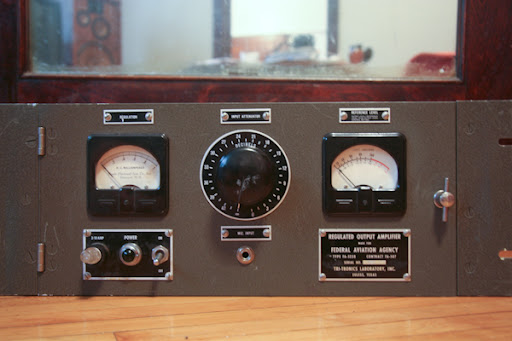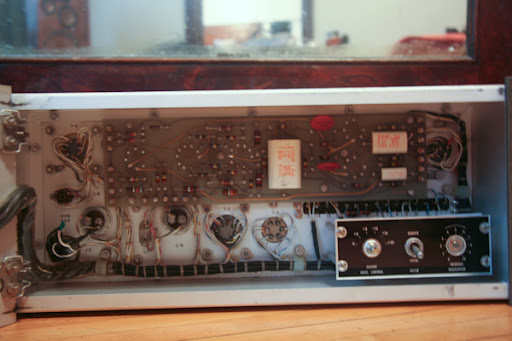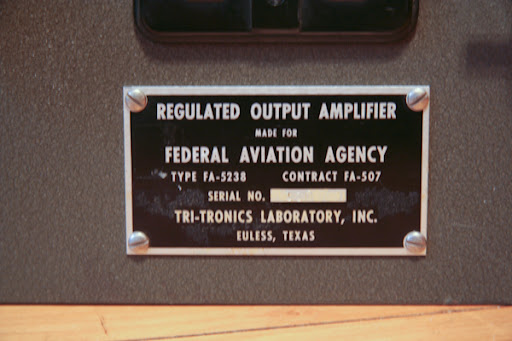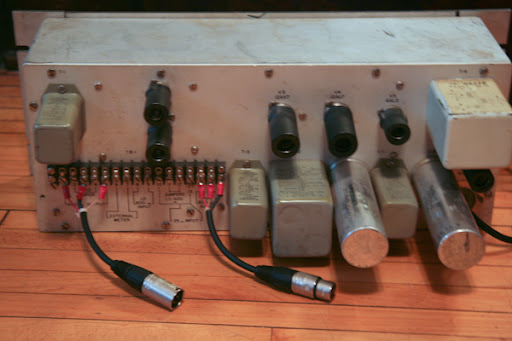A client of mine bought this unit thinking it was one of the 864/u limiters, and was disappointed to find out that it's not. He wants me to see if I can turn it into something more useful (ie a preamp or compressor). I've searched around, but can't seem to find a schematic. It already has a mic input which appears to be wired to an input transformer (all the wiring is laced together, which is beautiful, but not easy to trace), and it has a section labeled output regulation, but I'm not entirely sure how this is implemented without spending some more time with it. It's very possible that there's some sort of side chain and the "regulation" could be some sort of vari-mu style bias regulation. It's also possible that it's simply a line amp with a mic input and an output control labeled "regulation." The thing is a work of art though, and it's certainly beefy (three transformers, a choke, and six tubes). The tube compliment is: 6X4 rectifier, 5726(6AL5), 6189W(12AU7), 12AX7WA, and a pair of 6AU6WC's. The hardest part about getting this going is finding a suitable replacement for the chassis-mount 4uF @ 600V caps. If anyone here knows anything about this unit or has any ideas, I'd love the input. If anyone has a schematic, you'll make me a very happy guy. Here are some pics:
**Doug identified this as a Maxson Dept. of Commerce Limiter (thanks again)
For those of you who can't see the pictures, here are some links:
http://lh6.ggpht.com/_IAJCNj0PC6g/SgyVd_Ei0WI/AAAAAAAAAPc/VL-A-eOnEl4/Federal1.jpg
http://lh4.ggpht.com/_IAJCNj0PC6g/SgyVeApLMBI/AAAAAAAAAPg/Cbpy293Ep6Q/Federal2.jpg
http://lh4.ggpht.com/_IAJCNj0PC6g/SgyVeIzDQcI/AAAAAAAAAPk/NENW-KeLU-0/Federal3.jpg
http://lh5.ggpht.com/_IAJCNj0PC6g/SgyVeV-P6CI/AAAAAAAAAPo/dQqJkgmB8LM/Federal4.jpg




**Doug identified this as a Maxson Dept. of Commerce Limiter (thanks again)
For those of you who can't see the pictures, here are some links:
http://lh6.ggpht.com/_IAJCNj0PC6g/SgyVd_Ei0WI/AAAAAAAAAPc/VL-A-eOnEl4/Federal1.jpg
http://lh4.ggpht.com/_IAJCNj0PC6g/SgyVeApLMBI/AAAAAAAAAPg/Cbpy293Ep6Q/Federal2.jpg
http://lh4.ggpht.com/_IAJCNj0PC6g/SgyVeIzDQcI/AAAAAAAAAPk/NENW-KeLU-0/Federal3.jpg
http://lh5.ggpht.com/_IAJCNj0PC6g/SgyVeV-P6CI/AAAAAAAAAPo/dQqJkgmB8LM/Federal4.jpg






